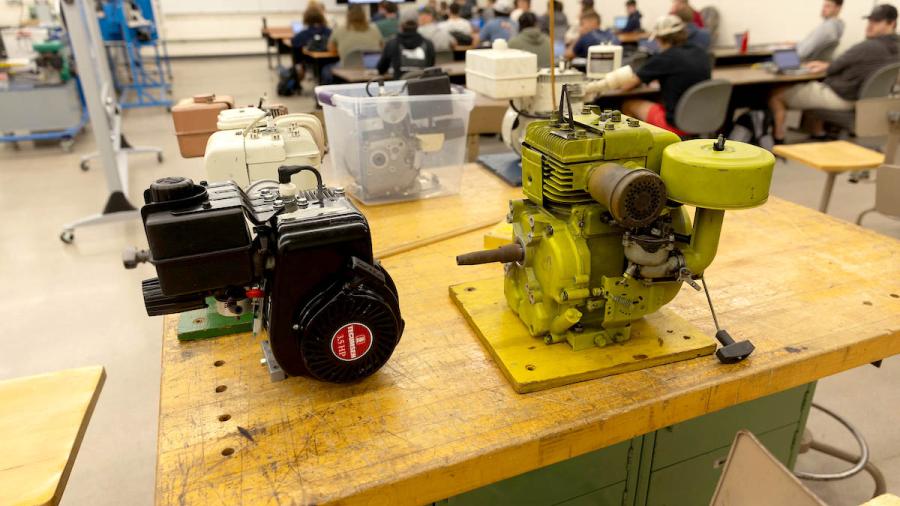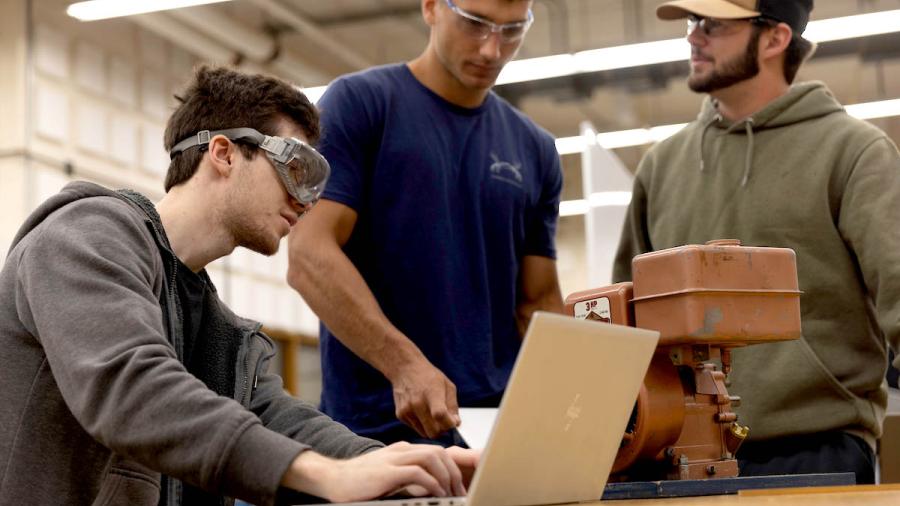When you think of a bicycle, what do you think of? Your dad helping you balance on your first ride without training wheels, cheering you on as you pedal down the block. Sticking cards in your spokes. Racing to the gas station for a soda pop in the summer. The freedom of the open trail before you.
If the word “machine” pops into your head, our guess is that you’re a mechanical engineer or determined to be one. You see the moving components, the system powered by the rider’s legs through the pedals, the chain, the wheels on pavement – the newtons of force necessary to propel the bike—a machine—forward.

Professor Devin Berg opens the first lab meeting of his Machine Component Design class with a short discussion on the mechanics of a bicycle. Then his students—mechanical engineering juniors and seniors—break into small groups to disassemble six small engines piece by piece, by hand to understand the multiple components, like gears, shafts and springs, that function as one to bring the engine to life. They will study these individual machine components throughout the semester before reassembling the engines.

The engines await at worktables throughout the Jarvis Hall Tech Wing lab. An echoing hum of the ventilation system and the insect-like buzz of overhead lights accompany the clank of metal on metal and the asynchronous clicks of half a dozen ratchet wrenches.
With so many sights and sounds filling the lab and so many engine parts dotting the tables, you’d think there would be a smell to the room—an odor of motor oil, reminiscent of your grandfather’s garage. But the lab is a clean, open space.

Bridgette Allen, a fourth-year student from Simi Valley, Calif., helps a team member who uses a spring compressor to remove a valve spring, which closes the valve to let oxygen in and exhaust out of the engine. Removing the one-inch coil from the two-by-three-inch space is delicate, dexterous work.
They talk each other through the process; two hands working to find a better grip on the spring compressor, while many sets of eyes, protected by safety goggles, search for a better view of the spring.

“Hands-on is all and everything we do in mechanical engineering,” said Allen, who interned as a quality engineer at Aerojet Rocketdyne in California this summer. “The majority of other interns hadn’t had any hands-on experiences before at their universities. I could talk with the engineers in their industry language.”
Allen was proud to fit in right away with the full-timers.

Trent Thompson, a fourth-year student from Eau Claire, and his team hunch over a four-stroke Briggs & Stratton engine used to power go-karts, gas-powered wood splitters, riding lawn mowers or mud-motors on duck boats.
“What we do in the labs at Stout carries over into our internships and careers,” he said. His lab experiences prepared him for his internship as a quality engineer with General Motors, in Bowling Green, Ky.

Teams take pictures on their phones and pull up diagrams of engines on their laptops for visual aids to remember the placement of the components as they remove them one by one. It is not an easy puzzle to disassemble. The organized chaos of discarded bolts, springs and valves begins to line the worktables.

Another team works to remove a flywheel, a machine component that preserves rotational inertia within the engine. Gavin Tschida, a fourth-year student from St. Paul, concentrates on pushing the flywheel loose from one end of the crankshaft while steadying the component with his other hand. “I chose mechanical engineering because it covers a wide variety of the field and gives me a lot of career options, like product development,” he said, without taking his eyes from the task at hand.

So, where’s that familiar smell you’ve been searching for? And where are the students wandering off to and returning with all of these tools?
Berg, who has an engineering tattoo on his left tricep—a gear tattoo—emerges from a side room with more spring compressors. The Tool Room. Here’s the smell you’ve been searching for—the warm, earthy scent of motor oil and metal.

Six metal cabinets are lined with screwdrivers, micrometers, hammers, mallets, pliers, wrenches, files—a mechanic’s tool shop. Anything and everything a mechanical engineer might need to get a motor running.





